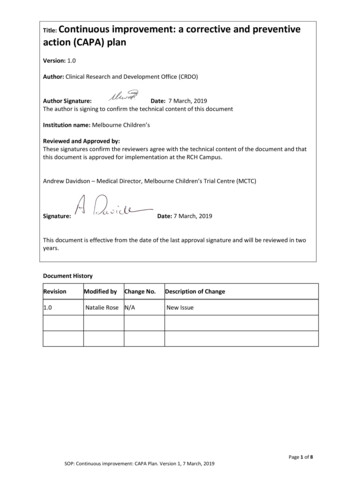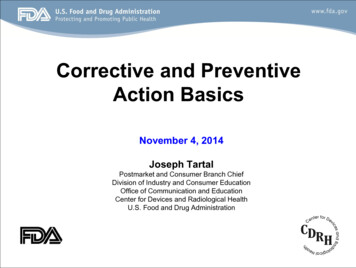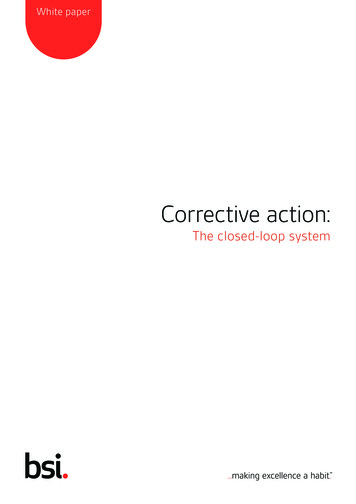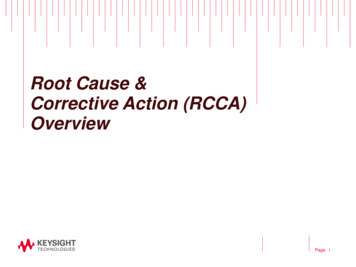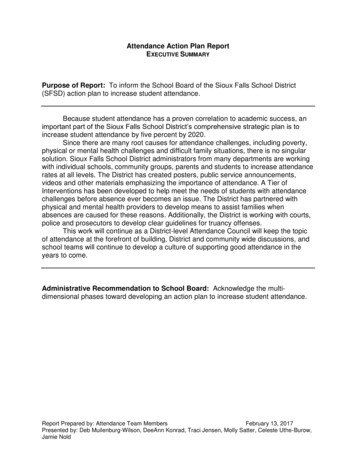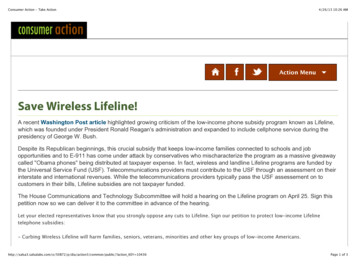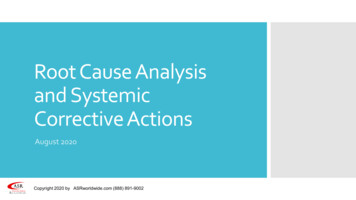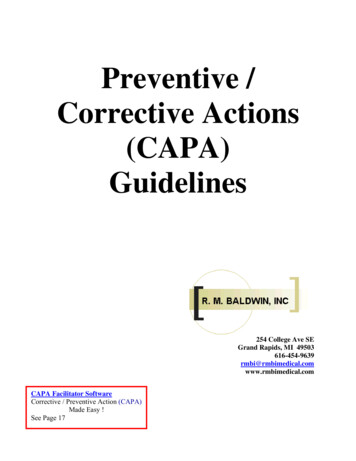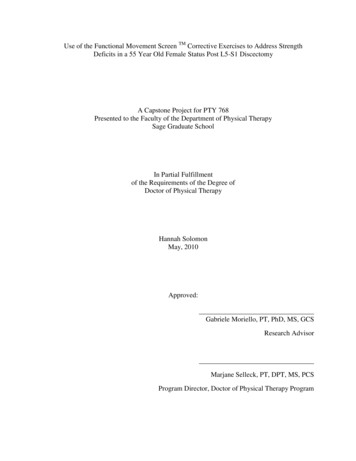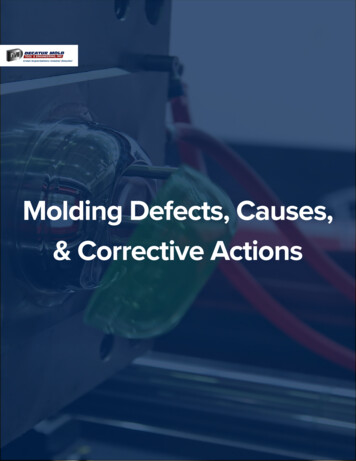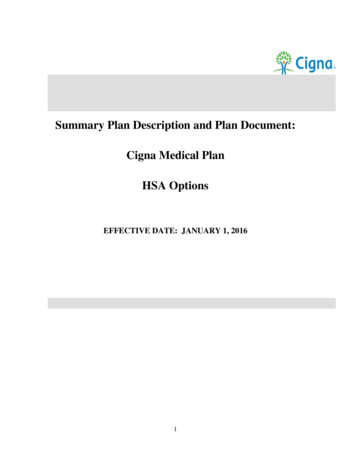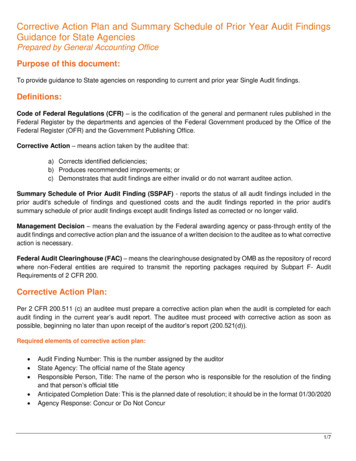
Transcription
Corrective Action Plan and Summary Schedule of Prior Year Audit FindingsGuidance for State AgenciesPrepared by General Accounting OfficePurpose of this document:To provide guidance to State agencies on responding to current and prior year Single Audit findings.Definitions:Code of Federal Regulations (CFR) – is the codification of the general and permanent rules published in theFederal Register by the departments and agencies of the Federal Government produced by the Office of theFederal Register (OFR) and the Government Publishing Office.Corrective Action – means action taken by the auditee that:a) Corrects identified deficiencies;b) Produces recommended improvements; orc) Demonstrates that audit findings are either invalid or do not warrant auditee action.Summary Schedule of Prior Audit Finding (SSPAF) - reports the status of all audit findings included in theprior audit's schedule of findings and questioned costs and the audit findings reported in the prior audit'ssummary schedule of prior audit findings except audit findings listed as corrected or no longer valid.Management Decision – means the evaluation by the Federal awarding agency or pass-through entity of theaudit findings and corrective action plan and the issuance of a written decision to the auditee as to what correctiveaction is necessary.Federal Audit Clearinghouse (FAC) – means the clearinghouse designated by OMB as the repository of recordwhere non-Federal entities are required to transmit the reporting packages required by Subpart F- AuditRequirements of 2 CFR 200.Corrective Action Plan:Per 2 CFR 200.511 (c) an auditee must prepare a corrective action plan when the audit is completed for eachaudit finding in the current year’s audit report. The auditee must proceed with corrective action as soon aspossible, beginning no later than upon receipt of the auditor’s report (200.521(d)).Required elements of corrective action plan: Audit Finding Number: This is the number assigned by the auditorState Agency: The official name of the State agencyResponsible Person, Title: The name of the person who is responsible for the resolution of the findingand that person’s official titleAnticipated Completion Date: This is the planned date of resolution; it should be in the format 01/30/2020Agency Response: Concur or Do Not Concur1/7
Corrective Action Plan and Summary Schedule of Prior Year Audit FindingsGuidance for State AgenciesPrepared by General Accounting Office **Note** If an agency does not agree with an audit finding they should contact GAO as soon as possible,even if the actual finding hasn’t been received. Auditors typically provide advance notice that theyanticipate a finding long before it is received.Corrective Action Plan: Narrative of the planned corrective action.As you prepare to write a response consider the following: Objective – Preparing a plan to correct the finding. Audience – As part of the management decision process Federal agencies will review corrective action plans to verify the planned action will prevent reoccurrence of similar findings and recoverquestioned costs. The Federal grantor is the audience.o What does the Federal grantor need to know will be done?What are the recommendations of the audit?o Generally, if the recommendations are implemented the finding should be resolved.o What are the steps to implement the recommendations?What are the anticipated hurdles?What is the required level of effort to resolve?What is a realistic timeframe to completion?o Correcting noncompliance can be a lengthy process, measured in years rather than months.Federal grantors and auditors will be following up later to ensure the corrective action plan hasbeen implemented as indicated, is it measurable?Federal findings identify the area of noncompliance. Read the related section of the OMBCompliance Supplement Part 3 for additional information on how to comply with that areaOver the last five single audits, an average of 63% of recommendations involved creating,reviewing or enforcing policies and procedures. Having written policies and procedures willhelp reduce the overall number of findings. Common issues with responses:o Over-promise – If a law change is required, ensure research is done on how that wouldooobe achieved and the probability it can be doneUnder-promise – Federal grantors review the plans, if the plan does not adequatelyaddress the issue, the grantor will require additional actions. Additionally, the finding willnot be resolved and occur again.Unrealistic timeframe – Resolutions that involve outside vendors etc. will likely take a lotof planning, more people involved, and external processes. Even internal corrections canbe difficult to complete timely as it may require coordination between multipledepartments. It is important to do the legwork before committing to a resolution timeframe.If an anticipated completion date is given and not met, additional explanations arerequired.Does not address the issue – The response should be concise and address the actualissue/cause of the finding. If the issue is there are no desktop procedures, the plan shouldbe getting the procedures written and distributed.2/7
Corrective Action Plan and Summary Schedule of Prior Year Audit FindingsGuidance for State AgenciesPrepared by General Accounting OfficeoToo much detail – The response should address the required elements and be as conciseas possible. Again, if the issue is there are no desktop procedures, the plan should begetting the procedures written and distributed. The Federal grantor does not need to knowthe location of the procedures. When the audit team follows up they may ask that question,but that is part of the audit work, do not include it in the response.Directions for Writing a Corrective Action Plan1. Indicate the strategy—the specific means, method, or approach to solving the identified problem(s).2.List the major actions that must be taken to implement the strategy. They should be listed in order ofcompletion. In articulating the actions, stay focused on the big picture, naming only the most significant toachieve resolution. However, the owner of a specific action step may wish to add detail to the internal actionplan to guide his or her particular work. An optional internal action plan document provided below.3. The actions should be written such that they indicate the measures of implementation that tell when theaction step or strategy is fully realized or carried out.Summary Schedule of Prior Audit Findings:Per 2 CFR 200.511 (b) The summary schedule of prior audit findings (SSPAF) must report the status of allfindings included in the prior audit’s schedule of findings and questioned costs in addition to audit findingsreported in the prior audit’s SSPAFs if they were not listed as fully corrected or no longer valid.Required elements of a summary schedule of prior audit findings: Audit Finding Number: This is the number assigned by the auditorState Agency: The official name of the State agencyStatus: Fully Corrected, Partially Corrected, Not Corrected, No Longer ValidReason for Findings Recurrence: Explanation of why the finding recurredCorrective Action Taken to Date: Describe what corrective actions have been takenRemaining Corrective Actions: Describe what corrective actions remainSignificant Differences from Previously Reported Corrective Action Plan: If applicable, explain whycorrective action taken is significantly different from corrective action previously reported.As you prepare to compile the SSPAF consider the following: Objective – Providing a status update of the plan, including any changes to the plan. Audience –Federal agencies will review as part of their follow up of audit findings3/7
Corrective Action Plan and Summary Schedule of Prior Year Audit FindingsGuidance for State AgenciesPrepared by General Accounting Office What was the corrective action plan?o What progress has been made on the plan?o What is left to be done? A well-planned CAP will lead to an easy summary of status as of 6/30. An example document touse for planning and tracking status is below. Is the plan on target to complete by anticipated date?o Correcting noncompliance can be a lengthy process, measured in years rather than months. Common issues with summary schedules of prior audit findings:o Does not include required information – The elements required in the SSPAF is dictatedby the Code of Federal Regulations, GAO and the auditors will be reviewing to ensurerequired information is included. It causes delays in the Single Audit process whenrequired elements are not included initially.o Too much detail – The Federal grantor is reviewing this information to determine the statusof the corrective action. Concise responses are ideal, what was the step and has it beenimplemented or is it in progress?o Status is incorrect – see belowStatus considerations Fully corrected means that the corrective action is fully implemented as of 6/30 of the fiscal year underaudit. Partially corrected means that corrective actions are in progress as of 6/30 of the fiscal year under audit. Not corrected means that no corrective actions have occurred as of 6/30 of the fiscal year under audit. No longer valid means that:1. Two years have passed since the audit report in which the finding occurred was submitted to the FAC2. The Federal agency or pass-through entity is not currently following up with the auditee on the auditfinding AND3. A management decision was not issued4/7
Corrective Action Plan and Summary Schedule of Prior Year Audit FindingsGuidance for State AgenciesPrepared by General Accounting OfficeExample finding:Finding: 2018-101CFDA number and name: 93.111Award numbers and years: 2017XYZ, 2017Federal agency: U.S. Department of Health and Human ServicesCompliance Requirement: Subrecipient MonitoringQuestioned Costs: NoneCriteria: In accordance with 2 CFR 200.331(f) pass-through entities should ensurethat a subrecipient expending 750,000 or more in federal awards during thesubrecipient’s fiscal year has met the audit requirements for that fiscal year.Condition and Context: The Department did not always ensure that subrecipientsexpending 750,000 or more in federal awards met the audit requirements.Effect: The Department did not follow 2 CFR 200.331(f) requirements for ensuringthat subrecipients expending 750,000 or more in federal awards submit a single auditreport.Cause: The Department did not have adequate documented policies and proceduresRecommendation: To help prevent noncompliance the Department should developand implement written policies and procedures.Example corrective action plan:Finding: 2017-101Agency: DepartmentName of contact person and title: D. Clark Partridge, State ComptrollerAnticipated completion date: 08/30/2019Agency’s response: Concur5/7
Corrective Action Plan and Summary Schedule of Prior Year Audit FindingsGuidance for State AgenciesPrepared by General Accounting OfficeThe Department agrees with this finding and will implement the following: Develop policies and procedures that require confirmation that subrecipientsexpending 750,000 or more in federal awards submit a single audit reportDistribute policies and proceduresTrain staff on the new policies and proceduresExample summary schedule of prior audit finding:Audit Finding Number: 2018-101CFDA number and name: 93.111State Agency: DepartmentStatus: Partially CorrectedThe corrective action plan was anticipated to take over a year to implement due to themultiple departments involved in the coordination of resolution.The Department has implemented the following: Develop policies and procedures that require confirmation that subrecipientsexpending 750,000 or more in Federal awards submit a single audit reportDistributed policies and proceduresThe following actions are in the process of being implemented: Train staff on the new policies and proceduresResources:Compliance Supplement ederal-financial-management/Code of Federal Regulations Title 2 Part 200 Uniform Administrative Requirements Cost Principles and AuditRequirements for Federal Awards https://www.ecfr.gov/cgi-bin/textidx?SID 62315501a25f84d68e61f1ba16aac86f&mc true&node pt2.1.200&rgn div5#sp2.1.200.f6/7
Corrective Action Plan and Summary Schedule of Prior Year Audit FindingsGuidance for State AgenciesPrepared by General Accounting OfficeExample of an optional internal document to monitor the progress of the corrective action planToday’s Date:Owner:Strategy:Action StepsResourcesMeasures ofOwnerImplementationDeadlineCompletedWhat stepsWhat specificWhat is theWho is mostWhen willHas the stepmust be takensupports areindication thecloselythe step bebeento implementneeded toaction step is fullyresponsible andcompleted?completed?our correctiveimplement thisrealized or carriedaccountable foraction plan?action step?out?taking each actionstep?7/7
A well-planned CAP will lead to an easy summary of status as of 6/30. An example document to use for planning and tracking status is below. Is the plan on target to complete by anticipated date? o Correcting noncompliance can be a lengthy process, measured in years rather than months. Common issues with

